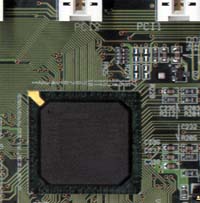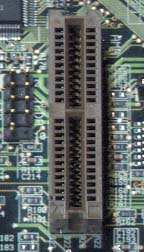The I/O Controller Hub (ICH)
 The i820 uses the same i82801AA ICH that the
i810 made use of. The 801AA provides the functions normally reserved to the South Bridge
of a chipset. Here is an excerpt from our i810 review that explains the functions of the
801AA ICH:
The i820 uses the same i82801AA ICH that the
i810 made use of. The 801AA provides the functions normally reserved to the South Bridge
of a chipset. Here is an excerpt from our i810 review that explains the functions of the
801AA ICH:
The ICH is the connecting force between the PCI bus, the USB ports, as well as a newcomer to the motherboard, the AMR slot. The ICH provides a direct connection to the 2 IDE channels (4 devices), the 2 USB ports, the PCI bus, and the Super I/O which drives the keyboard, mouse, FDD, serial and parallel ports.
Although there are two versions of the ICH, the ICH and the ICH0, it would be very rare that the ICH0 is used on an 820 board. The ICH, supports Ultra ATA 66/33 and supports a maximum of 6 PCI slots with an optional ISA bridge. The ICH0, supports Ultra ATA 33, and a maximum of 4 PCI slots with an optional ISA bridge. Although ISA bridges are supported by the chipset, it is highly unlikely that you'll see too many 820 boards outfitted with ISA slots.
Audio Modem Riser
 It looks like 1/3 of an AGP slot, when in
actuality it is the latest addition to the acronyms tech junkies will have to remember,
AMR, or the Audio Modem Riser slot. The AMR slot allows users to take advantage of the
chipset’s integrated Audio/Telephony codecs via a single card rather than wasting
money on a software modem (ala Winmodem).
It looks like 1/3 of an AGP slot, when in
actuality it is the latest addition to the acronyms tech junkies will have to remember,
AMR, or the Audio Modem Riser slot. The AMR slot allows users to take advantage of the
chipset’s integrated Audio/Telephony codecs via a single card rather than wasting
money on a software modem (ala Winmodem).
The inclusion of the Audio/Telephony codecs allows motherboard manufacturers to produce Audio/Modem ready mainboards without having to actually test and certify the components on the Audio/Modem cards themselves. Then, after producing and releasing the board, an optional AMR card can be installed that will provide the output ports for the Audio/Telephony devices. The reason this is a more cost effective solution is because the Audio/Telephony devices are software devices that are essentially powered by your CPU. For some users, a soft modem or soft audio device makes sense, because how much of a Pentium III 600 will you be using while you're surfing the net? However, for others, it makes very little sense, such as having a soft audio/modem while playing some Quake 3 Arena on-line.
Motherboard manufacturers will be offering hardware sound/modem devices as an option as well. Chances are that hardware sound will be a preferred option by gamers since you don't usually want to waste all too many clock cycles working on producing audio when they could be boosting your frame rate.










0 Comments
View All Comments